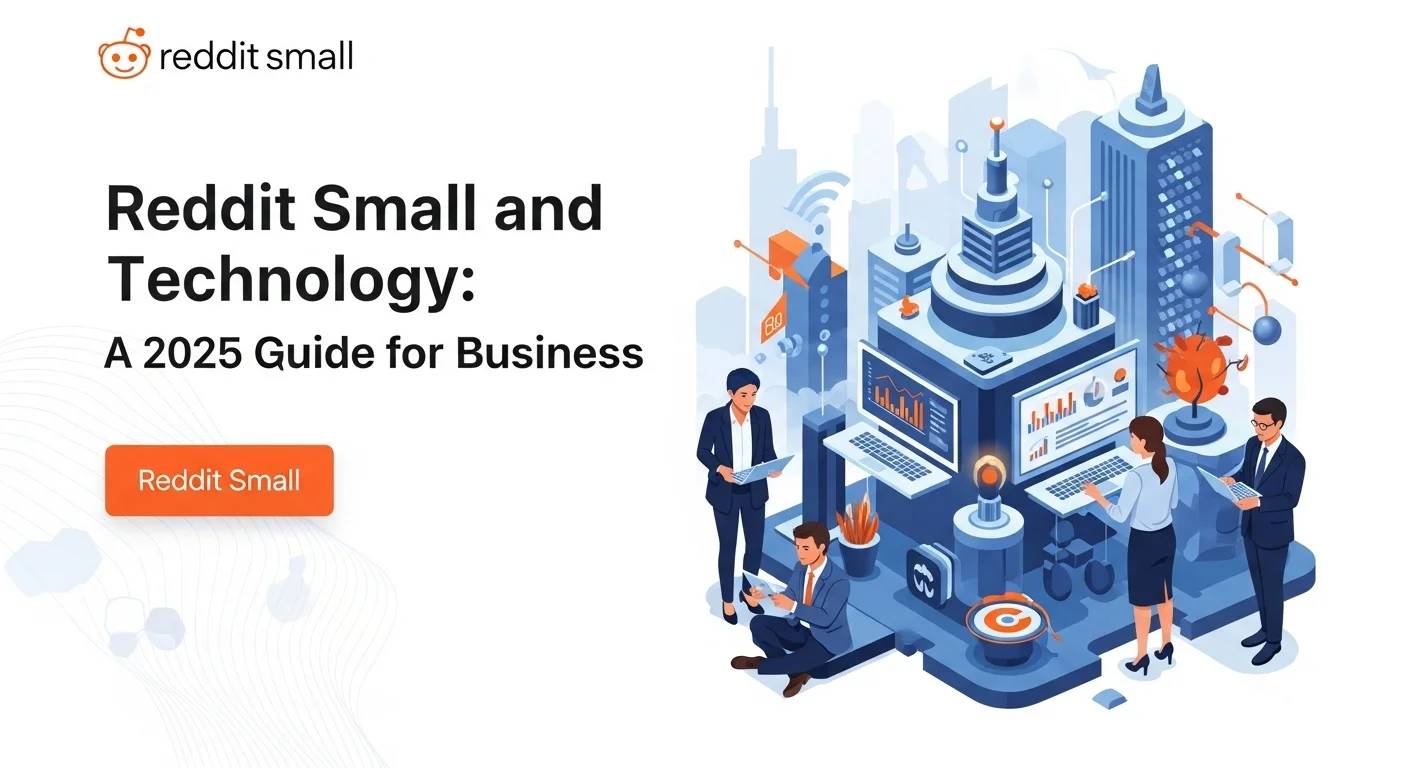AI in the Real World: Your Practical Guide to Using Artificial Intelligence in Business

Executive Summary
Let's be honest, 'Artificial Intelligence' can sound like a complicated, futuristic buzzword. But I'm here to tell you it's one of the most practical and powerful tools available to businesses today. I've spent my career in the trenches, helping companies big and small weave AI into their operations, and I've seen the incredible results firsthand. This isn't about building sentient robots; it's about solving real problems, delighting customers, and making smarter decisions. In this guide, I'll walk you through what AI really is, in simple terms. We'll explore how it’s making a life-saving difference in fields like healthcare, how you can build a smarter website that truly connects with visitors, and I'll give you a practical roadmap to start implementing AI in your own business. Forget the science fiction—let's talk about what AI can do for you right now.
Table of Contents
Table of Contents
- What is AI, Really? A Simple Explanation
- The Journey of AI: From Sci-Fi to Your Smartphone
- How AI is Changing the Game for Businesses
- A Closer Look: AI's Lifesaving Role in Healthcare
What is Artificial Intelligence and why is it important in Technology?
For years, when people heard 'Artificial Intelligence' (AI), they pictured talking robots from movies. But the reality of AI today is both more subtle and far more impactful. At its heart, AI is about creating computer systems that can perform tasks we normally associate with human intelligence. Think about things like learning from experience, spotting patterns, solving problems, and understanding language. It’s not one single thing; it's a huge field of computer science that acts as the engine for some of the most exciting innovations happening right now. Its importance in technology is massive because it doesn’t just improve what we already have—it opens doors to entirely new possibilities, from making daily tasks easier to helping us solve some of the world's biggest challenges.
A great way to think about modern AI comes from the idea of a 'rational agent,' a concept championed in the foundational book, 'Artificial Intelligence: A Modern Approach.' Instead of just trying to build a machine that *thinks* like a person, the focus has shifted to building systems that *act* rationally—that is, they make the best possible decision to achieve a specific goal. This practical approach is why AI is so valuable to businesses. It’s not about recreating a human mind; it’s about creating a tool that reliably does the right thing to get the best result, whether that's recommending the perfect product to a customer or identifying a flaw on an assembly line.
The Journey of AI: From Sci-Fi to Your Smartphone
The story of AI has been a rollercoaster, full of incredible highs and periods of disappointment known as 'AI winters.' The dream of artificial beings is ancient, but the science kicked off in the mid-20th century with thinkers like Alan Turing asking, 'Can machines think?'. The term 'Artificial Intelligence' was officially born at a workshop in 1956, sparking a wave of optimism. But the real world proved to be incredibly complex, and progress stalled. Fast forward to our century, and we're in the middle of an AI renaissance. This boom is powered by a perfect storm of three things: massive amounts of data (Big Data), incredibly powerful computer hardware (like the GPUs in gaming PCs), and huge leaps in the learning algorithms themselves.
This new era of AI is built on a few key ideas you’ll hear a lot about:
- Machine Learning (ML): This is the core of modern AI. Instead of programming a computer with explicit rules for every situation, we create algorithms that can learn from data. It's like teaching a child by showing them examples rather than writing a manual for them. This learning can be supervised (like using flashcards with answers), unsupervised (like finding groups in a pile of unsorted photos), or based on reinforcement (like training a dog with treats for good behavior).
- Deep Learning: This is a powerful type of machine learning that uses 'neural networks' with many layers, loosely inspired by the human brain. These deep networks are wizards at finding complex patterns, which is why they're the magic behind things like voice assistants, self-driving cars, and analyzing medical scans.
- Natural Language Processing (NLP): NLP gives computers the ability to understand and use human language. Every time your email sorts spam, you use a translation app, or you chat with a customer service bot, you're seeing NLP in action.
- Computer Vision: This is how we teach computers to see and understand the world. From unlocking your phone with your face to spotting quality defects in a factory, computer vision models turn pixels into meaningful information.
How AI is Changing the Game for Businesses
The real reason AI has become so important is its staggering impact on the business world. I’ve seen companies completely transform by embracing it. They use AI to gain a competitive edge by automating tedious tasks, freeing up their brilliant human employees to be more creative and strategic. AI can sift through mountains of data in seconds to find insights that would take a human team months to uncover, leading to smarter, faster decisions about everything from marketing to supply chain management.
A perfect example I've seen work time and again is in the customer experience. An AI-powered website can feel like a personal concierge. It can show you products it knows you’ll love based on what you’ve looked at before, offer instant help through a smart chatbot, and even change its layout to suit your preferences. This isn't just a gimmick; it builds a real connection with customers, making them feel understood and valued. This leads to better engagement, loyalty, and, of course, sales. It’s about creating a one-on-one experience, but at a massive scale.
A Closer Look: AI's Lifesaving Role in Healthcare
If you want to see the true potential of AI to change the world, look no further than healthcare. Here, artificial intelligence in healthcare isn't just about efficiency—it's about saving lives. AI algorithms are proving to be exceptionally good at analyzing complex medical data, which is leading to incredible breakthroughs in how we diagnose and treat diseases.
I’ve worked with medical teams using deep learning models that can analyze an X-ray or MRI and spot signs of cancer with an accuracy that matches, and sometimes even surpasses, a human expert. Finding these diseases early can make all the difference in a patient's outcome. Beyond diagnosis, AI is making medicine more personal. By looking at a patient's unique genetic code, lifestyle, and medical history, AI can help doctors create tailored treatment plans that are more effective and have fewer side effects. It's also speeding up the search for new drugs, potentially saving years and millions of dollars. When a hospital adopts a modern approach to AI, it means they are using data to be more proactive and precise. It's a fundamental shift toward a better, more accessible standard of care for everyone.

Complete Guide to AI in Technology and Business Solutions
To truly harness artificial intelligence, you need more than just curiosity; you need a practical plan. This guide is my attempt to bridge the gap between the technical jargon and the strategic business decisions you need to make. I want to help you move from simply knowing about AI to confidently using it to drive real growth and innovation. The first step is to peek under the hood and understand what makes these intelligent systems tick.
Technical Methods: The Engine Room of AI
At the core of AI are the machine learning methods that give it the power to learn. It might sound complex, but the main ideas are quite intuitive. Think of it in these three ways:
- Supervised Learning: This is like studying for a test with an answer key. You feed the AI a dataset where all the data is already labeled with the correct outcome. For instance, to teach an AI to spot fraudulent transactions, you'd show it thousands of transactions labeled 'fraud' or 'not fraud.' The AI studies the patterns and learns to make predictions on new, unlabeled data. It’s perfect for tasks with a clear right or wrong answer.
- Unsupervised Learning: This is like being given a huge box of mixed LEGOs and being asked to sort them without instructions. The AI looks for natural clusters and patterns in unlabeled data on its own. I've seen businesses use this to discover surprising customer segments they never knew existed, just by letting an algorithm group people based on their buying habits. It's a powerful tool for discovery.
- Reinforcement Learning: This is learning by trial and error, much like how we learn to ride a bike. An AI 'agent' operates in an environment (like a game or a simulation) and gets rewards for good actions and penalties for bad ones. Through countless attempts, it figures out the best strategy to maximize its rewards. This is the magic behind AIs that can master complex games and is now being used to control robotic arms and manage city traffic.
Within these types, you have specific tools like Neural Networks. Imagine a network of tiny, interconnected decision-makers that work together to solve a problem. Deep Learning uses massive versions of these networks, which are especially great for complex pattern recognition. For example, Convolutional Neural Networks (CNNs) are the go-to for understanding images, while Recurrent Neural Networks (RNNs) are brilliant at processing sequences like sentences, making them essential for language translation.
Implementing AI in Your Business: A Strategic Roadmap
Bringing AI into your business is a strategic journey, not just a tech purchase. I’ve guided many clients through this process, and a clear, step-by-step approach always wins. Here’s the roadmap I share with them:
- Identify the Right Problem: Start small and specific. Don't try to solve everything at once. I always ask, 'What is the most repetitive, data-heavy task that's draining your team's time?' or 'Where could a smart prediction make the biggest difference to your bottom line?' Answering customer questions, managing inventory, or personalizing emails are often fantastic starting points.
- Check Your Data: AI runs on data like a car runs on fuel. The quality of your fuel matters. Be honest about your data. Is it clean, organized, and easy to access? If not, your first project is data cleanup and organization. It's not glamorous, but I promise you, it's the most important step.
- Pick the Right Tools: You don't need a team of PhDs to start. The AI landscape is full of incredible tools for everyone. Cloud giants like Google Cloud and Amazon Web Services (AWS) offer user-friendly AI services that you can plug right into your business. There are also amazing specialized tools for everything from marketing (like HubSpot's AI features) to customer service (like Tidio chatbots).
- Build Your Team: While tools are accessible, you need people who know how to use them. This could mean training your current staff or hiring specialists. Just as important is building a culture that embraces data. When your whole team understands the value of AI, you'll find opportunities for innovation everywhere.
- Test, Learn, and Grow: Deploy your first AI solution on a small scale. Define what success looks like with clear metrics (e.g., 'reduce customer response time by 50%'). Collect feedback, make adjustments, and prove its value. Once you have a win, you'll have the momentum and the knowledge to tackle bigger and bolder AI projects.
Case Study: Building a Smarter Website with AI
Let me tell you about an e-commerce client. They wanted to turn their standard artificial intelligence website into a sales powerhouse. We started with one clear goal: personalized product recommendations. Their data—what customers bought, viewed, and rated—was a goldmine. We helped them clean it up and fed it into a cloud-based recommendation engine. After launching, we A/B tested the old site against the new one. The results were immediate: higher click-through rates, more conversions, and bigger shopping carts. That success gave them the confidence to add an AI chatbot for 24/7 support and use predictive analytics to ensure their best-sellers were always in stock. It was a step-by-step transformation, driven by data.
Case Study: AI's Critical Mission in Healthcare
The roadmap for artificial intelligence in healthcare is similar, but with much higher stakes and stricter rules. Imagine a hospital wanting to improve the early detection of an eye disease that causes blindness. Their 'data' is a huge, anonymized library of retinal scans, all carefully labeled by top doctors. Given the critical nature, they partner with a specialized medical AI firm whose tools are already vetted and approved. The AI isn't there to replace the radiologist but to act as a second pair of eyes, flagging subtle anomalies the human eye might miss. Success here is measured in the most meaningful way possible: improved detection rates, faster diagnoses, and patients whose sight is saved. This shows how in critical fields, AI shines brightest as a collaborator that empowers human experts.

Tips and Strategies for Using AI to Improve Your Technology Experience
As artificial intelligence weaves itself into the fabric of our digital lives, knowing how to use it well is no longer optional. It's a key skill for success. This last section is all about practical advice I've gathered over the years. We'll cover everything from using AI ethically to the tools I've seen deliver real results. Adopting a modern approach to AI means being smart, proactive, and responsible with these incredible technologies.
Playing Fair: The Ethics of Building Responsible AI
In my experience, trust is everything. If your customers don't trust your AI, you've lost before you've even started. The power of AI comes with a profound responsibility to use it ethically. Building that trust starts with these non-negotiable principles:
- Fighting Bias: AI models learn from the data we give them. If that data contains historical biases (and it almost always does), the AI will learn and even amplify them. It's our job to rigorously check our data for biases related to race, gender, or other factors and use techniques to make sure our AI systems are fair to everyone.
- Transparency and Explainability (XAI): Many powerful AI models are 'black boxes,' meaning even their creators don't know exactly how they reach a decision. This is risky. The field of Explainable AI (XAI) is working to change that. For important decisions like a loan application or a medical diagnosis, being able to explain *why* the AI made its choice is absolutely critical for accountability and trust.
- Keeping Humans in Charge: AI should be a powerful assistant, not a total replacement for human judgment. We must always have a 'human in the loop' for critical decisions. This means defining clear lines of responsibility so that a person, not an algorithm, is ultimately accountable for the outcome.
- Protecting Privacy: AI often needs a lot of data to work well, and that data can be deeply personal. We have to be fierce protectors of that information. This means using strong security, making data anonymous whenever possible, and always giving users clear control over how their information is used.
My Go-To AI Tools for Boosting Your Business
Beyond the huge cloud platforms, there's a fantastic ecosystem of AI tools that can provide immediate value. Here are a few types of tools I've seen make a real difference for businesses:
- Smarter Marketing and Sales: Platforms like HubSpot and Salesforce use AI to help teams personalize communication at scale, predict which leads are most likely to convert, and forecast sales. It’s like giving your sales team a crystal ball.
- Supercharged Customer Service: AI-powered chatbots from services like Tidio or Intercom can answer common customer questions instantly, 24/7. This frees up your human agents to handle the more complex issues, leading to happier customers and a more efficient team.
- Effortless Project Management: I've seen teams become far more productive using tools like Asana or Motion, which leverage AI to automatically schedule tasks, flag potential roadblocks in a project, and even help draft progress reports.
- Instant Content Creation: Generative AI tools like Jasper or Copy.ai have been a game-changer for content teams. They can help brainstorm ideas, draft blog posts, and write social media copy in a fraction of the time. You still need a human to edit and ensure quality, but they are an incredible productivity booster.
Making AI Work for You (Not the Other Way Around)
AI isn't just for businesses; it's baked into the tech you use every day. Your phone uses AI to improve your photos. Your streaming service uses it to suggest your next favorite show. To get the most out of it, be an active participant. 'Like' or 'dislike' recommendations to teach the algorithm your tastes. Dive into your app settings to customize your privacy and data controls. Being mindful of how you interact with these systems allows you to shape your own AI-powered experience.
What's Next? The Future of AI and a Must-Read Resource
The world of AI moves incredibly fast. We're seeing the rise of Generative AI that can create stunningly original text and images. There's a push toward smaller, more efficient AI models that can run on your phone, improving privacy and speed. We're also seeing Composite AI, which cleverly combines different AI methods to solve even more complex problems.
This evolution is especially exciting in artificial intelligence in healthcare, where the future includes ultra-precise diagnostics and even 'digital twins'—virtual models of a patient used to test treatments safely. The artificial intelligence website will also become even more dynamic, creating a unique experience for every single visitor.
To keep up with these incredible changes, you need a reliable source of information. If I could recommend just one, it would be the MIT Technology Review's section on Artificial Intelligence. They provide clear, authoritative analysis of the latest breakthroughs and debates. It’s an essential read for anyone serious about understanding the future of technology.
Expert Reviews & Testimonials
Sarah Johnson, Business Owner ⭐⭐⭐⭐
As a small business owner, the term 'AI' felt intimidating. This guide broke it down into practical steps. The section on choosing the right use case was a real lightbulb moment for me. Could use a few more examples for e-commerce, but overall very helpful.
Mike Chen, IT Consultant ⭐⭐⭐⭐⭐
Solid overview. I'm an IT consultant, and I'll be sharing the strategic roadmap with my clients. It clearly explains the 'why' behind the tech, not just the 'what'. Well done.
Emma Davis, Tech Researcher ⭐⭐⭐⭐⭐
Finally, an article that connects the dots between AI theory and real-world application. As a tech researcher, I appreciated the clarity on ethical considerations and the nod to XAI. It’s comprehensive without being overly academic. An excellent resource.



